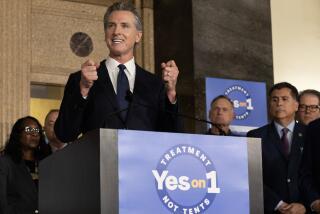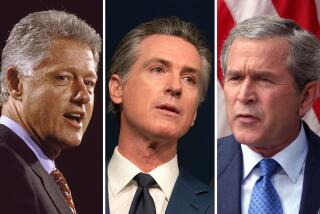Newsom cashes in on primary victory, far outraising Cox in California governor’s race

Democrat Gavin Newsom emerged from California’s gubernatorial primary with a prodigious financial advantage over Republican rival John Cox, banking more than seven times as much money for the general election.
As of June 30, California’s two-term lieutenant governor and the front-runner in the race, has more than $11 million in the bank, while Cox has $1.5 million, according to campaign finance reports filed with the state Tuesday.
Newsom’s financial position is not surprising — he has led in fundraising since he entered the race in 2015. He is also seeing a burst of new contributions from donors who supported Antonio Villaraigosa, his top Democratic rival in the primary.
But Cox, a wealthy Rancho Santa Fe businessman who donated $5.5 million to his campaign, has been receiving larger donations since he consolidated the GOP vote to place second in the June 5 primary. And he could easily write more seven-figure checks to his campaign.
Newsom’s dominance in fundraising and a recent post-primary opinion poll spell trouble for Cox, said Sacramento-based Republican strategist Rob Stutzman. Newsom had a 24-percentage-point lead over Cox in a recent poll by the Public Policy Institute of California, and Californians have not elected a GOP candidate in a statewide race since 2006.
“To really be competitive and win, a Republican needs to run a $40-million to $60-million campaign for the fall,” Stutzman said. “It’s a big challenge. It’s not unique to Cox.”
Stutzman served as a senior advisor to Republican Meg Whitman in 2010 when the former eBay president and chief executive spent $178.5 million, including $144 million of her own money, on an unsuccessful gubernatorial bid. Whitman was trounced by Democrat Jerry Brown.
The campaign finance reports released this week cover fundraising and spending between May 20 and June 30, a period that included the heated lead-up to the primary and the campaign bills that came due afterward.
Newsom spent nearly $5 million during that period, while Cox spent $1.2 million, according to the reports. Villaraigosa spent nearly $1.2 million, but benefited from millions of dollars in spending by outside groups on his behalf during that period.
But the spending largely didn’t rejigger the race, and donors began shifting allegiances once they observed the direction the election was likely to take.
Notable Villaraigosa supporters who donated to Newsom shortly before the primary or in the weeks after include music executive Clarence Avant, investor Robert Beyer, film producer Steve Bing, the Del Mar Thoroughbred Club, former Disney chief executive Michael Eisner and Paramount Pictures chairman and chief executive James Gianopulos.
Perhaps the most notable donation came from Netflix founder Reed Hastings, who donated more than $7 million to pro-Villaraigosa and anti-Newsom efforts — nearly all of which went to an independent-expenditure committee formed by charter-school backers that broke spending records, but ultimately proved ineffective.
Three weeks after the primary on June 26, Hastings donated $29,200 — the maximum allowed by law — to Newsom’s general election effort.
Coverage of California politics »
Hastings did not respond to a request for comment.
Villaraigosa’s supporters could be taking cues from the former Los Angeles mayor, who endorsed Newsom during his concession speech on June 5, and in person two weeks later.
Some donors who contributed to the two candidates said both are well qualified to be the state’s next governor.
Bill Bloomfield, a wealthy centrist South Bay donor who is registered “no party preference,” said he and his wife, Susan, maxed out their donations to Villaraigosa immediately after he launched his bid in November 2016 because of their preexisting relationship and Villaraigosa’s support of the education-reform movement. The couple also donated the maximum amount to Newsom’s primary bid the following year.
And after the primary, they each contributed $29,200 to Newsom’s general election bid.
“He’s the only one left, so I maxed out to Gavin,” Bloomfield said. “They were both very well qualified to be governor, though obviously they ran different campaigns.”
When Cox entered the governor’s race in early 2017, he vowed not to run a self-funded campaign. But since then he has not hesitated to tap his substantial wealth. Of the $8.3 million he has raised since launching his bid for governor, $5.5 million came from Cox himself.
Still, the Cox campaign saw a substantial increase in donations after his second-place finish in the primary. Excluding his own contributions, Cox raised $1.2 million in June alone. That haul was more than double the amount he raised in May, which, until then, had been his most successful fundraising month of the race, state campaign finance records show.
Twenty-two supporters have written $29,200 checks to the Cox campaign since he advanced to the November election. Cox didn’t receive a maximum contribution before then, state campaign finance records show. Those donors included the Lincoln Club of Orange County, but most have not been major financial players in previous gubernatorial campaigns.
For the past two decades, California has been a political graveyard for wealthy, self-funded candidates running for governor.
Republican Neel Kashkari dropped $3.1 million into his 2014 campaign for governor, which helped him survive past the primary only to be roundly defeated by Brown in the general election. Democrat Al Checchi, the former co-chairman of Northwest Airlines, spent $40 million in the 1998 governor’s race and came in second place to Gray Davis in the Democratic primary. Democrat Steve Westly, a former state controller and eBay executive, spent $35 million of his own money in a failed 2006 gubernatorial bid.
And Republican Steve Poizner, a former state insurance commissioner, contributed $24 million in the 2010 governor’s race only to lose to Whitman in the GOP primary, who spent much more on her campaign. (Poizner is currently running for state insurance commissioner as an independent “no party preference” candidate.)
Melinda Jackson, a political scientist from San Jose State University, said it’s a mistake to think that having a flush bank account and a crew of well-paid political consultants will pave a path to success. Even in mammoth California, where television ads have traditionally been the best way to reach the most voters, there are benefits to the retail politics of community fundraisers and campaign rallies.
“It’s a real blind spot for some of these wealthy candidates,” Jackson said. “When you’re self funding, you’re not out talking to people and hearing what their concerns are.”
Times staff writers Maloy Moore and Ryan Menezes contributed to this report.
Follow California politics by signing up for our email newsletter »
seema.mehta@latimes.com; phil.willon@latimes.com
Follow @LATSeema and @philwillon on Twitter.
More to Read
Get the L.A. Times Politics newsletter
Deeply reported insights into legislation, politics and policy from Sacramento, Washington and beyond. In your inbox three times per week.
You may occasionally receive promotional content from the Los Angeles Times.








